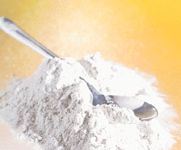Measuring Excipient-Market Growth
Moderate growth is projected for the global excipients market. Excipient producers target blends and new grades for improving functionality and performance.
The global market for excipients is projected to grow at a stable rate for the next several years. New blends and grades of existing excipients are providing innovative ways to enhance multifunctionality and performance.

PHOTO: STOCKBYTE/GETTY IMAGES
Market growth and segments
The global market for excipients was $3.5 billion in 2006, according to BCC Research (1). The market is expected to increase at a compound annual growth rate (CAGR) of 3.8% through 2011 and reach $4.3 billion (see Table I). The global excipients market is broken down into three major segments: organic chemicals, inorganic chemicals, and United States Pharmacopeia (USP) water.

Patricia Van Arnum
Organic chemicals. Carbohydrates represent the largest share of global organic excipients on a value basis, followed by petrochemicals, oleochemicals, and proteins. Carbohydrates account for 39%, or $1.2 billion, of the global organic excipient market based on 2006 data. Petrochemicals account for 30.3%, or $941 million, and oleochemicals 28.3%, or $880 million. Proteins represent a small percentage, only 2.2%, or $68 million, according to BCC Research (1).
Carbohydrates are the leading organic excipients because of their filling and taste-masking properties, according to BCC. Cellulosics hold the top spot in the carbohydrates segment on a value basis. Sugars comprise the bulk of the market volume for carbohydrates. Micronized cellulose phthalate and hydroxylpropyl cellulose compositions that have been converted to gels for transmucosal delivery systems are driving growth for cellulosics. BCC projects increased demand for compendial sugars for biopharmaceuticals and growth for artificial sweeteners, particularly in thin-film strips (1).

Table I: The global excipient chemicals market (1).
Glycols and povidones are the leading petrochemical-based excipients. "The trend in glycols is toward more refined grades that can increase stability of active pharmaceutical ingredients (APIs) by as much as threefold," reports BCC. "Also, the emergence of very small tablets with rapid bioavailability is helping to boost usage of povidones." For oleochemicals, demand is oriented toward topical products and shows relatively flat growth (1).
Inorganic chemicals. Inorganic chemicals used as pharmaceutical excipients include calcium salts, halites, metal oxides, and silicates. Calcium salts hold 73.2%, or $266 million, of the global inorganic excipients market, according to BCC. The firm points to several key developments for calcium salts:
- The expiration of Rhodia's (Paris) patent for anhydrous technology, which could open the market to other products
- The morphing of calcium phosphate from an excipient to a value-added product in a drug-delivery system
- The development of a slow-release full-protection vaccine embedded into injectable microspheres made from dissolvable calcium-phosphate crystals; the microspheres surround nanoparticles containing the API.
Halites and metal oxides each comprise 8.5%, or $31 million, of the global market for inorganic excipients. Demand for sodium chloride as an osmotic agent in injections and sustained-release tablets provides halites a CAGR greater than that of other inorganic excipients, according to BCC. The established use of titanium dioxide as a colorant is driving sales growth of metal oxides. Silicates account for 4.8%, or $17 million, of the global market for inorganic excipients. Small loading levels and the maturity of the glidant segment keep the market for silicates low. Other inorganic excipients account for 5%, or $18 million (1).
USP water. BCC Research classifies USP water as a general chemical in its analysis of the global excipient market. USP water includes water for injection (WFI) and purified water. Water must comply with USP standards for chemical purity and microbial content (i.e., < 0.25 ppm of endotoxins). WFI accounts for 76.5% of the USP water market, or $52 million, and purified water 23.5%, or $16 million (1).
Pharmaceutical grades of water used in drug-process applications (i.e., enema and medical-irrigating fluids) and other than those used to formulate excipients are excluded from the analysis. Also excluded is water used as: a pharmaceutical manufacturing process aid (i.e., wet granulation); a solvent for aqueous-based, film-coating materials; a cleaning and rinsing material for containers and closures; a fermentation or cell-culture media ingredient; an extraction and purification solvent; a chemical-reaction solvent; or any other purpose except in a formulated drug-dosage form.
Excipient innovation
Excipients serve various functions within a pharmaceutical formulation. Table II breaks down the global excipient market by functional type on a value and volume basis. An ongoing goal of excipient development is to achieve multifunctionality with a single or a reduced number of excipients in a formulation. Despite increased interest by pharmaceutical companies to add functionality, excipient producers say it is difficult to bring new excipients to market.

Table II: Global excipients market by functional type (1).
"As there is not an approval process for excipients, the introduction of new materials for use as excipients takes a very long time, and most suppliers are not willing to invest as the rewards do not justify the investment for a material new to the industry," explains Tim Bee, senior director of the global pharmaceuticals business at International Specialty Products (ISP, Wayne, NJ).
"The cost of new excipients in terms of the need for toxicology studies is prohibitive for most excipient companies," adds Alen Guy, vice-president of research and development at JRS Pharma (Patterson, NY). "The return on investment is not there, and such a venture needs a 'slam dunk' application to receive senior-level approval."
Wider options
Although introducing new excipients is a slow and costly process, the excipient market is not without innovation. Excipient makers use a strategy of developing excipient blends to achieve multifunctionality and introduce new grades of existing excipients to enhance performance for specified applications. Excipients for orally disintegrating tablets (ODTs) and controlled-release formulations are recent examples.
Orally disintegrating tablets. In September 2007, BASF launched "Ludiflash," a coprocessed excipient consisting of three ingredients: a special grade of mannitol used as a filler; crospovidone used as a superdisintegrant; and a polyvinyl acetate dispersion used as a binder. Ludiflash was specifically developed for the manufacture of ODTs but can also be used as granules or powder in sachets. Because it contains a filler, binder, and disintegrant, only the API and a lubricant are added to the formulation. Colorants and taste-masking agents may also be used.
"Ludiflash offers properties not achievable by simply blending the three ingredients," explains Dr. Ralf Widmaier, marketing manager at BASF SE (Ludwigshafen, Germany). "It offers a wide-processing window and very good hardness and low friability of the tablets at disintegration times within 10–30 s in the mouth without drinking water."
Fast-melt or quick-dissolving formulations pose certain challenges in excipient selection. "APIs that have an extreme sensitivity to water may pose problems for API stability since the excipients usually contain water in the amount of 4–5% by weight," says Widmaier. "In this case, it can help to coat the API to protect it from the water present in the excipient."
The pressure on the API during tableting is another consideration. "The excipient should diminish the pressure on the coated API granules, so that these granules are not being damaged during compression to the final tablet," says Widmaier.
The filler and binder may also affect the ODT. The filler should dissolve readily in water and saliva without increasing the solution's viscosity. "Otherwise, the entrance of water into the tablet will be delayed, and the disintegration time increases," explains Widmaier. "For the binder, quick dissolution diminishes the speed of disintegration."
BeneoâPalatinit (Mannheim, Germany) markets a high-solubility grade of "galenIQ 721" (pharmaceutical-grade isomalt) for ODTs. Beneo–Palatinit introduced galenIQ two years ago as a filler and binder. The product is derived from sucrose. Through enzymatic transglucosidation, sucrose is converted to the disaccharide 6-O-α-D-glucopyranosyl fructose, a reducing compound, which is hydrogenated. This process results in the stereoisomer disaccharide alcohol 1-O-α-D-glucopyranosyl-D-mannitol dihydrate and 6-O-α-D-glucopyranosyl-D-sorbitol in an approximate equimolecular mixture, explains Bodo Fritzsching, head of pharmaceutical sales and technical services at Beneo–Palatinit. Through additional processing, the ratio of the two molecular components can be varied, resulting in grades with different solubilities. The lower soluble galenIQ 720 (solubility 24.5 g/100 g at 20 °C) is used in sublinguals that dissolve slowly in the oral cavity or for swallowable tablets that erode within several minutes. The other grade, galenIQ 721 (solubility 41.5 g/100 g at 20 °C), shows good disintegration properties and can be used with crospovidone for fast and very fast disintegrating tablets.
Isomalt is used with ODTs formulated through direct compression. "The number of fillers and binders in this area is limited because these bulk excipients have to fulfill special requirements from a technology and sensorial view," says Fritzsching. Because galenIQ is based on sucrose, it offers taste-masking potential, thus adding functionality to the formulation.
Other producers point to limitations in attaining multifunctionality. "The concept of an excipient product that provides two functions, such as binder and disintegration, is appealing," says Bee. "However, there are usually compromises in the overall performance and a loss in formulation flexibility. The excipient is not as effective at doing one of the functions as effectively as an excipient that provides a single function." ISP provides "Polyplasdone" (crospovidone) for ODTs.
Controlled-release formulations. Excipient producers are also targeting excipients to improve the performance of controlled-release formulations. "Direct compression is the lowest cost, quickest-to scaleup process for controlled-release formulations," says Kacee Ender, pharmaceutical applications development specialist in the pharmaceutical excipient research and development group of Dow Wolff Celullosics, a business unit of the Dow Chemical Company (Midland, MI). Dow Wolff Celullosics recently introduced two new hypromellose products for direct compression of controlled-release matrix oral dosage forms. "Methocel" K4M and "Methocel" K100M premium DC grades are viscosity grades designed to improve powder flowability while maintaining compressibility, tablet hardness, and controlled-release performance, says Ender.
JRS Pharma's "ProSolv SMCC" (silicified microcrystalline cellulose (MCC) is a multifunctional exicipient that can be used in controlled-release applications. "The surface roughness and colloidal silicon dioxide (CSD) adds flow, but it allows the excipient to be more effective in producing dry-blended, ordered mixtures, which in turn improves content uniformity," explains Guy. "The product is differentiable from MCC–CSD blends in its interaction with water. Several companies have used this property for matrix-controlled release systems."
Patricia Van Arnum is a senior editor at Pharmaceutical Technology, 485 Route One South, Bldg F, First Floor, Iselin, NJ, 08830, tel. 732.346.3072, pvanarnum@advanstar.com
References
1. "Excipients in Pharmaceuticals" Report No. PHM010E, BCC Research (Norwalk, CT, 2006).
For more on innovation in excipients, see the online exclusive: "Tracking the Potential of Excipients"

Drug Solutions Podcast: A Closer Look at mRNA in Oncology and Vaccines
April 30th 2024In this episode fo the Drug Solutions Podcast, etherna’s vice-president of Technology and Innovation, Stefaan De Koker, discusses the merits and challenges of using mRNA as the foundation for therapeutics in oncology as well as for vaccines.
Drug Solutions Podcast: Applying Appropriate Analytics to Drug Development
March 26th 2024In this episode of the Drug Solutions Podcast, Jan Bekker, Vice President of Business Development, Commercial and Technical Operations at BioCina, discusses the latest analytical tools and their applications in the drug development market.
INTERPHEX 2025: Use of Walk-In Chambers for Bio/Pharma Development and Manufacturing
April 2nd 2025Sitting down with the PharmTech Group at INTERPHEX 2025, Christopher Murphy, director of Global Business Development and Service Customer Support at Environmental Specialties, discusses the design and critical role of walk-in chambers in the bio/pharmaceutical industry.